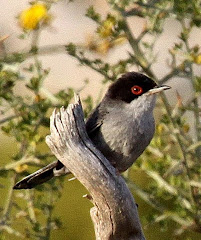The intermittent appearance of five different species of raptor kept the other bird-life under great stress. Most persistent were two Marsh Harriers which relentessly quartered the marsh and pools.
.jpg)
.jpg)
Lapwings and other waders appeared to be their main target but on several occasions the Lapwings retaliated when in sufficient numbers by mobbing the harriers although even the Greylags seemed to show some apprehension.
.jpg)
.jpg)
.jpg)
.jpg)
A Peregrine gave an impressive aerial display lasting several minutes, mainly chasing the Lapwings but failed to make a catch and departed elsewhere. A Hobby made a single pass over the pools but was also unsuccessful. This bird was very pale in the vent area and was presumably a juvenile. An isolated Lapwing resisted an attention from a Sparrowhawk whilst two Buzzards circled harmlessly high overhead.
The Whiskered Tern which had been present here for several days seemed to have departed but there were at least five Greenshank, three Ruff, a Black-tailed Godwit and Little Stint on the pools. Migrant Hawker dragonflies flew in good numbers around the reed beds.
.jpg)
.jpg)
.jpg)
.jpg)
.jpg)
.jpg)
.jpg)
.jpg)
.jpg)
.jpg)
.jpg)
.jpg)
.jpg)
.jpg)
.jpg)
.jpg)
.jpg)
.jpg)
.jpg)
.jpg)
.jpg)
.jpg)



